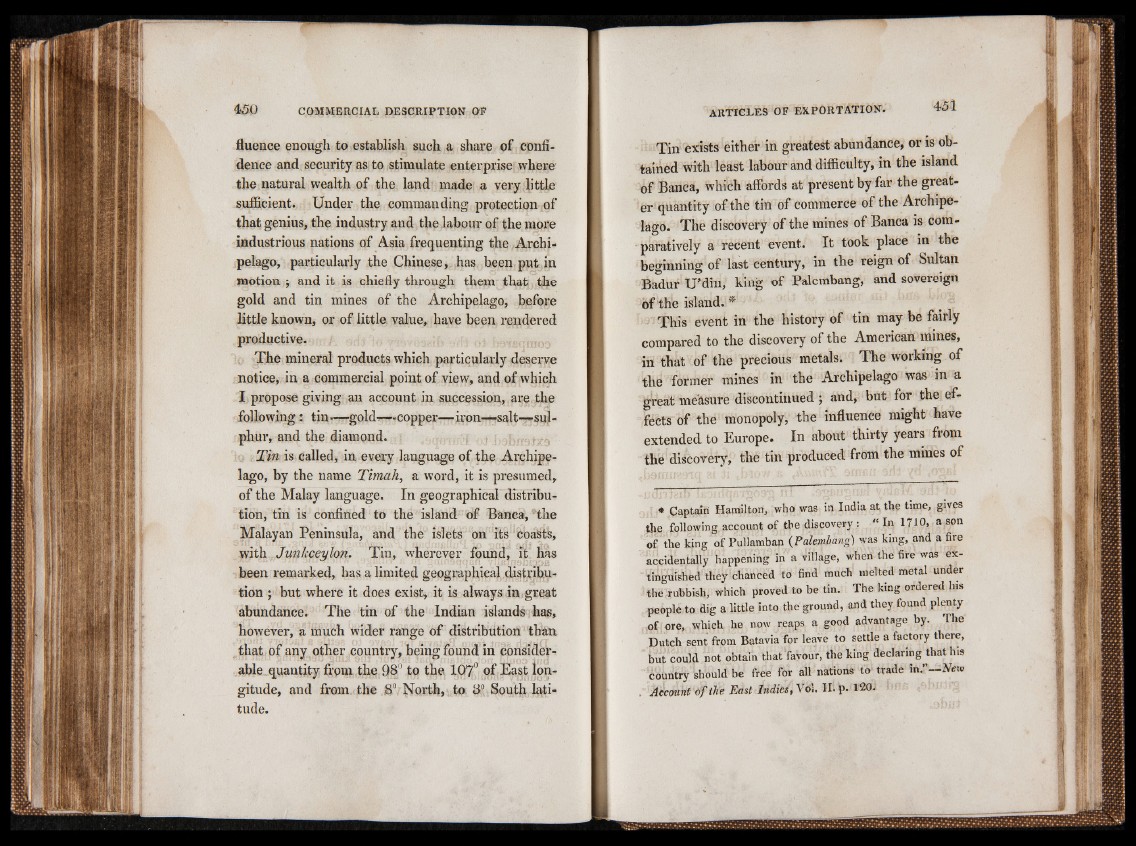
fluence enough to establish such a share of confidence
and security as to stimulate enterprise where
the natural wealth of the land made a very little
sufficient. Under the commanding protection of
that genius, the industry and the labour of the more
industrious nations of Asia frequenting the Archipelago,
particularly the Chinese, has been put in
motion; and it is chiefly through them that the
gold and tin mines of the Archipelago, before
little known, or of little value, have been rendered
productive.
The mineral products which particularly deserve
notice, in a commercial point of view, and of which
I propose giving an account in succession, are the
following : tin— gold^—-copper— iron—salt—sulphur,
and the diamond.
Tin is called, in every language of the Archipelago,
by the name Timah, a word, it is presumed,
of the Malay language. In geographical distribution,
tin is confined to thé island of Banca, fthe
Malayan Peninsula, and the islets on its ’coasts,
with Junkceylon. Tin, wherever found, it has
been remarked, has a limited geographical distribution
; but where it does exist, it is always in great
abundance. The tin of the Indian islands has,
however, a much wider range of distribution than
that of any other country, being found in considerable
quantity frpm the 98° to the 107° of East longitude,
and from the 8° North, to 83 South latitude.
Tin exists either in greatest abundance, or is obtained
with least labour and difficulty, in the island
of Banca, which affords at present by far the greater
quantity of the tin of commerce of the Archipelago.
The discovery of the mines of Banca is comparatively
a recent event. It took place in the
beginning of last century, in the reign of Sultan
Badur U’din, king of Palembang, and sovereign
of the island. *
This event in the history of tin may be fairly
compared to the discovery of the American mines,
in that of the precious metals. The working of
the former mines in the Archipelago was in a
great measure discontinued ; and, but for the effects
of the monopoly, the influence might have
extended to Europe. In about thirty years from
the discovery, the tin produced from the mines of
* Captain Hamilton, who was in India at. the time, gives
the following account of the discovery : “ In 1710, a son
of the king of Pullamban (Palembang) was king, and a fire
accidentally happening in a village, when the fire was extinguished
they chanced to find much melted metal under
the rubbish, which proved to be tin. The king ordered his
people to dig a little into the ground, and they found plenty
of ore, which he now reaps a good advantage by. The
Dutch sent from Batavia for leave to settle a factory there,
but could not obtain that favour, the king declaring U»at his
country should be free for all nations to trade In."— New
Account o f the East Indies, Vol. II. p. 120.